Exhibition itinerary
> Texte français
![]() Education / Media supports
Education / Media supports
Exhibition itinerary
> Texte français
|
|
|
|
| Monogram, 1955-59. Freestanding combine |
When creation means combining, assembling, incorporating
Parody and its different manifestations
The relationship of artwork with time
Following on from the Metropolitan Museum of Art in New York and the Museum of Contemporary Art in Los Angeles, the Centre Pompidou, Musée National d’art moderne presents, from 11 October 2006 to 15 January 2007, the exhibition entitled “Robert Rauschenberg: Combines (1953-1964)”.
In the early 1950s, Rauschenberg launched his artistic career with series of monochrome paintings in black, white, gold and red, featuring varied textural effects produced by the marouflage and painting of newspaper. Even then he wanted to abolish from art the sacrosanct principle of self-expression. These surfaces, and in particular his white paintings, offer themselves as mirrors, neutral surfaces waiting to accept the reflections of the world. “Today is their creator,” the artist once said of these works. The Combines period followed immediately after. “Rauschenberg: Combines” is the first exhibition dedicated exclusively to this essential creative phase of the artist, which marked the beginning of his international artistic influence.
As the name suggests, the Combines are hybrid works that associate painting with collage and assemblage of a wide range of objects taken from everyday life. Neither paintings nor sculptures, but both at once, Rauschenberg’s Combines invade the viewers’ space, demanding their attention, like veritable visual puzzles. From stuffed birds to Coca-Cola bottles, from newspaper to press photos, fabric, wallpaper, doors and windows, it is as though the whole universe enters into his combinatorial process to join forces with paint. A friend of John Cage, Rauschenberg also took an interest in sound, and in his later Combines, he developed analogies between music and visual arts. Through his affinity with Merce Cunningam and dance, some of his works became stage décors.
“It is neither Art for Art, nor Art against Art. I am for Art, but for Art that has nothing to do with Art. Art has everything to do with life, but it has nothing to do with Art,” Rauschenberg once declared. (Interview with André Parinaud, in the catalogue of the exhibition Paris New York Paris, Musée national d’art moderne, Editions du Centre Pompidou, 1977.)
In the wake of the invention of collage by Braque and Picasso, as well as that of Dadaist assemblage, Rauschenberg reinvented these practices, giving them new impact in his Combines. A child of Dada, Rauschenberg was influenced by the assemblages of Kurt Schwitters, whose example led him to suggest that art and life are but one. Nevertheless, as Barbara Rose has pointed out, Rauschenberg’s art drew its inspiration from the America of that era, and the artist was reacting against Abstract Expressionism and its goal of the absolute when he incorporated images from magazines or non-artistic materials into his works. As with any great artist, the influences on his work can be sought far afield; among the painters who have marked him profoundly, the artist cites Leonardo da Vinci and his Annunciation (1475-1478) at the Uffizi Gallery in Florence. “Since his painting is life, the tree, the rock, the Virgin are all given the same importance at the same time. There is no hierarchy. This is what interests me.” (Interview with André Parinaud, op.cit.) The same can be said of the Combines, where each element maintains its own integrity without obscuring the others. The present and the past, press photos or reproductions of masterpieces of Western art, drawing and painting, cushions and boxes are incorporated into his works, as they attempt to introduce “totality into the moment”.
After Combines came the Silkscreen period in which the image and its reproduction took an increasingly important place and coexisted with painting. Using the solvent technique to transfer images to silk, Rauschenberg allowed to his passion for the photographic image, which has never left him, to rise to the surface. Having initially hesitated between becoming a painter or a photographer, the artist has in fact managed to reconcile the two disciplines. These works developed an increasingly close resemblance to mirrors, on which is inscribed, through different processes of using press images (transfer, montage and collage), the history of the United States in the 1960s. The artist then changed countries and used the world as the motif for his work. From silk to metal – the mirrored or enamelled aluminium of the Urban Bourbon series, copper for the Borealis series, brushed aluminium for the Night Shade series of the 1990s – and to transfers on paper for Waterworks (1992-93), Rauschenberg has never ceased assessing and making the most of the different creative possibilities of substrates, images and paint.
Maintaining increasingly subtle relations between painting and sculpture, photographic image and abstraction, claiming to represent a Total Art, which includes music and dance and in which time is an element of visual artwork, the artist continues to question and exceed the boundaries between art forms.
Whereas Jaspers Johns (who, like Rauschenberg, is one of the precursors of Pop Art), has described Rauschenberg as the most inventive artist of the 20th century since Picasso, art historian Leo Steinberg wrote, “what he invented above all was... a pictorial surface that let the world in again.”
Concentrating on the key period
of the Combines, this dossier studies three fundamental aspects:
- setting up the construction
process of the work: when creation means combining, assembling, incorporating,
- parody and its different
manifestations,
- the relationship of the work
with time.
WHEN CREATION
MEANS COMBINING, assemblING, inCORPORATING ![]()
Since Picasso’s Nature morte à la chaise cannée [Still life with cane chair] (1912), followed by Duchamp’s Roue de bicyclette [Bicycle wheel] (1913), Kurt Schwitters’ collages and assemblages, collages and assemblages of surrealist objects, the 20th century has continued to call for the real in artwork. Reacting – together with Jaspers Johns – against the aesthetic of Abstract Expressionism which dominated in the United States in the 1950s, Rauschenberg, a confirmed rebel and experimenter, reintroduced the real in his work (the real that had disappeared behind the fervent brush strokes of Pollock, De Kooning and other abstract expressionists) in a bid to attain the absolute and the sublime in art.
From the beginning, the artist has proclaimed: “I want to incorporate into my painting any objects of real life.” (Interview with André Parinaud, op.cit.) Although close in spirit to Dadaism and Schwitters’ use of discarded objects as a creative principle, Rauschenberg distinguishes himself through the dimensions of his works; very large, they invade the viewer’s space. “I would like to make a painting and a situation that leaves as much space for the person looking at it as for the artist.” (ibid.)
Whereas in a Picasso collage, the object or the heterogeneous material is inserted into the framework of the composition, in the Combines, the objects are simultaneously caught in the web that integrates them and are highly recognizable, and as such are rejected. All pictorial illusions and the idea that an artwork has only one meaning are thwarted. “In Rauschenberg’s work, the image depends not on the transformation of an object, but rather on its transfer. Taken from its place in the world, an object is embedded in the surface of a painting. Far from losing its material density in this operation, it asserts, to the contrary and insistently, that the images themselves are a sort of material.” (Rosalind Krauss, “Rauschenberg and the Materialized Image”, in L’originalité de l’avant-garde et autres mythes modernistes [French translation of The Originality of the Avant-garde and Other Modernist Myths (1985)], Macula, 1993). This observation holds for all Rauschenberg’s work, whether it involves an image or an art photo, a shirt or a tyre.
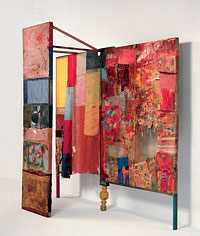
![]() Minutiae, 1954
Minutiae, 1954
Freestanding combine
Oil, paper, fabric,
newspaper, wood, metal, plastic with mirror, on wooden structure, 214.6
x 205.7 x 77.4 cm
Minutiae is one of the first and most important freestanding Combine paintings. Designed for a dance performance for his friend Merce Cunningham, the work is from the outset at the centre of life. It consists of three vertical panels of different sizes, connected to each other.
As in all the Combines paintings, the surface is irregular, covered with newspaper clippings of comic strips, old photos and pieces of posters. Paint covers the entire piece, in the form of drips or coloured surfaces. Between the panels is a passage in which a multicoloured fabric curtain serves as the element joining the different parts. This fabric, attached to the top of the panels, allows the dancers to pass through. Wood, metal, plastic, and a mirror mingle in this composition dominated by reds, yellows and blues. On the left panel is a curious plant motif, as if thrown there with a few brush strokes and almost intact in its pictorial vivacity, resembling an ancient fresco from Pompeii, which attracts the viewer’s attention, by suddenly introducing an element from another time and place.
All at once a screen, a stage prop and a painting, this Combine painting presents itself as an open structure. Requiring more than a simple glance, this work does not demand the multiplicity of viewpoints, but the “multiplication of gazes”, as Catherine Millet has noted, adding that the Combines incite us to pass freely through the work. (“Le corps morcelé de la sculpture, Robert Rauschenberg” [The divided body of sculpture, Robert Rauschenberg] in Art Press, no. 90, March, 1985.)
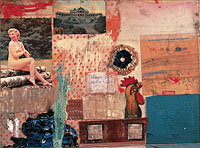
![]() Untitled, 1955
Untitled, 1955
Combine painting
Oil, crayon, pastel,
paper, fabric, print reproductions, photographs and cardboard on wood,
39.3 x 52.7 cm
Titles are of much importance to Rauschenberg. “They are all starting points. They are there when I begin my work, either I try to be consciously provocative or funny or macabre… The title is like another object in the work. It’s a deliberately solid and complex thought that obliges you to circle about the pieces, since because of them, you have the impression of never being in the right place.” (Interview of Robert Rauschenberg by Catherine Millet and Myriam Salomon, in Art Press, no. 65, December, 1982).
Therefore, when the artist calls a work Untitled, he gives full force to the absence of a title. There is no prior entry into the subject of the painting that the viewer can grab hold of, no starting point to restrain the imagination. The viewer is left alone to face the sensitive and open experience of the work. “If you talk too much about it, you see nothing. My work is made to be seen,” the artist has declared. The viewer is confronted here with a work that requires an examination, piece by piece, of the different elements that compose it, but without the artist insisting that one element has any meaning with respect to another. For what Rauschenberg wanted to do was to create paintings that “two people cannot see in the same way”. In reference to this, Catherine Millet has subtly emphasised that “Rauschenberg considers art as a means of individuation, opposed to everything in the social, ideological, political... or magical domain, that brings things together.” (Art Press, no. 90, op.cit). He does not seek community of the imagination. His art divides more than it assembles the immense catalogue of images, objects and things that are the world.
In this Combine, the artist juxtaposes images from magazines, photographs, fragments of posters, patterned fabric on which the paint slides. The image of a female nude sitting at an angle across tree trunks contrasts with the horizontal frontality of the building flying the American flag, while at the feet of the young woman a line of turquoise paint leads to a pool of blue.
Despite the fact that other elements such as the partially repainted patterned fabrics and other surface irregularities hinder a certain reading of the work, the cryptic reference to famous works of Western painting may be mentioned. The female nude is sitting on logs that evoke the broken column in Giorgione’s The Tempest (ca. 1506), which, in the Venetian artist’s painting, divides the composition into two scenes, one with the woman sitting in the grass nursing her baby, the other with the young herdsman. The river flowing between the two figures of this enigmatic painting might be recalled by the blue paint flowing at the feet of the young woman in Rauschenberg’s work.
The rooster, its head erects in the lower right hand corner of Untitled, is strongly connoted in other works of the artist as an allusion to masculinity, again evoking the two figures of The Tempest.
Nude, river, column, feminine, masculine, the background of vegetation from which this image detaches itself and the rural background for the setting of The Tempest, there seem to be a constellation of elements here that evoke, in Untitled 1955, the name of a mythical work in the history of painting.
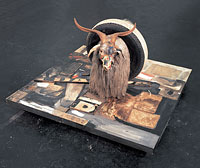
![]() Monogram,
1955-59
Monogram,
1955-59
Freestanding combine
Oil, printed paper,
printed reproductions, metal, wood, rubber heel and tennis ball on canvas,
with oil on angora goat and tyre on wooden base mounted on four casters,
106.6 x 160.6 x 163.8 cm
Monogram is one of the most famous Combines, which Rauschenberg reworked several times before achieving the final version. It is an incongruous association, on a sort of abstract painting placed horizontally, of an angora goat with a paint-daubed snout and a car tyre around its middle, and various collages ranging from a tennis ball to printed papers. This work bears no resemblance to the unique assemblages of the surrealists, illustrating Lautréamont’s famous expression: “As beautiful as the chance encounter of an umbrella and a sewing machine on a dissecting table” and evoking subconscious associations.
The combination of objects, images and lines of paint does not seek perceptive unity – despite the odd visual interlacing of the goat and the tyre – but division. The goat, despite the tyre it wears around its middle, remains implacably a goat and the tyre a tyre. The meaning of the assemblage is attained in this.
If the tyre is a reference to the artist’s childhood living close to a tyre factory, its association with the goat raises questions. The title Monogram renders this montage even more enigmatic: Monogram, or the interlacing of several letters to form a single character, composed here of the entanglement of the goat and the tyre. Thus the letter O passes around the animal to make a knot as a rebellion against meaning and all ideas of beauty. The Ready-made (tyre) and stuffed animal coexist in this work that, in keeping with the artist’s wishes, leaves as much place for the viewer as for the artist.
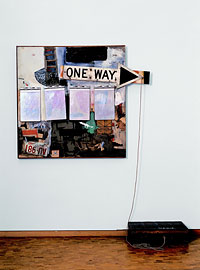
![]() Black Market, 1961
Black Market, 1961
Combine painting
Oil, watercolour,
crayon, printed paper, printed reproductions, wood, metal, metal box and
four notepads on canvas, with rope, rubber stamp, inkpad and various objects,
127 x 150.1 x 10.1 cm
Black Market was created for the exhibition L’Art en mouvement organised by the Stedelijk Museum in Amsterdam in 1961. As in the other Combines from the early 1960s, which link painting to sculpture, the work hung on the wall is continued onto the floor by a string attached to an open wooden suitcase containing various objects, and bearing the inscription “Open”.
The collage of elements on the surface recalls Monogram. Four writing pads with metal covers that can be raised and a “One Way” road sign draw the viewer’s attention, indicating the direction for reading the work from left to right. Paint, applied with brush strokes resembling those of Abstract Expressionism, links and emphasises the objects glued to the surface of the work.
Black Market was originally an interactive work requiring the participation of the viewer. In fact, on a card written in ten languages placed in the suitcase on the floor, Rauschenberg invited viewers to take an object from the case and replace it with one of their own personal objects. This object was to be drawn in one of the four notepads attached to the surface of the Combine, where the viewer was also to leave his or her signature. The artist thus proposed a trade with the public, a sort of “black market” as the title indicates, the work inciting the entry of objects that did not belong to the artist into the work and into the museum. (For a detailed analysis of this work, see the article by Branden W. Joseph, in the exhibition catalogue).
By insisting on the personal nature of the object that the viewer could contribute to the work, Rauschenberg emphasised their signification for the donor. The real traffic implicated in this trade is therefore, according to Branden W. Joseph, a “traffic in signification”. The viewer is not the producer of the work, but enters into a semantic game that changes its meaning. The movement that the work purportedly represents is not mechanical but should rather follow that of life: the life of the work that lends itself to the transformations contributed by the public; life that is also reflected in the metallic mirrors of the notepads that absorb the comings and goings of the viewers.
PARODY AND
ITS DIFFERENT MANIFESTATIONS ![]()
“To parody is always to transform an initial work.” (Etienne Souriau, Vocabulaire d’Esthétique, Puf, 1990). This creative process dawned before the 20th century, and is certainly as old as the first artistic successes. The parodied work has to be famous for the cultural reference to be understood by the viewer or reader (for literary works). Parodical works, as Souriau has also remarked, lend themselves to a “double reading”, which enables viewers to discover the parodied work behind the transformations of form and content. As is the case with some of Rauschenberg’s artworks, there is often a playful side and a certain amount of mockery involved in parody.
First by their resistance to signification, a result of the incoherent way in which they have been combined, the Combines parody the creative goal by expressing the subjectivity or subconscious that one might find in the artwork. By targeting famous artworks, Abstract Expressionism and its goal of the absolute, and the founding myths of our culture, Rauschenberg’s parody drains them of their substance and shows them from new angles.
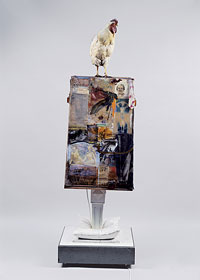
![]() Odalisk,
1955-1958
Odalisk,
1955-1958
Freestanding combine
Oil, watercolour,
crayon, pastel, paper, fabric, photographs, printed reproductions, newspaper,
metal, glass, pillow, wooden post and lamps on wooden structure with stuffed
rooster, 210.8 x 64.1 x 68.8 cm
The same year he began working on Odalisk, Rauschenberg produced the famous Bed, perceived as an object and a horizontal surface, which the artist presented hung vertically on the wall. The famous “open window” on the world to which Renaissance art had compared the picture plane, here becomes a real object that blocks the illusion.
Odalisk parodies an entire pictorial tradition of female representation. Ingres’s La Grande Odalisque (1814) in particular jumps to the viewer’s mind, evoked by the title and a few humorous details. In Rauschenberg’s work, for example, the cushion the young woman is lying upon in the Ingres painting conveys plump, feminine curves. Ingres’s odalisk displays her curvaceous nude figure on a bed of silk, where everything – the colours, light and shapes – is bathed in softness. The feather fan, draperies, and the delicate texture of the young woman’s skin promise sensual pleasure and appeal to the sense of touch.
Rauschenberg’s Odalisk is not only a painting, but a freestanding Combine that rests on the floor like a sculpture. It is a vertical construction made from a box open on two sides, topped with a rooster, and fastened to a white post mounted on a board with casters. A pillow is inserted between the white post and the base. The stuffed bird, a recurring theme in the Combines, moves from the global structure of the artwork into the actual space. The rooster is an obvious sexual allusion, the phallic complement to the odalisk figure. The artwork is covered with collages of images of female nudes from magazine photos and reproductions of erotic paintings – like Love and Psyche (1817) by François-Edouard Picot and Pastoral Concert (1509) attributed to Giorgione or the young Titian – echoing the motif of the recumbent concubine in a harem, reflected in the title Odalisk.
Reference to La Grande Odalisque is implicitly highlighted, weaving in and out of the perception of the artwork that is made from odds and ends and simply refers back to the inventory of its components. The exaggerated curves of the young female model call out to the crisp edges of the central box, the silky décor to the harsh surface of the different collages, and the sweeping glance of the entire Ingres painting to the need for multiple gazes. For the artwork requires the viewer to circle about it, draw nearer, and look inside the box at the blinking electric light bulbs.
Rauschenberg had created Untitled (also known as Man with white shoes) in 1954, the first freestanding Combine considered the male counterpart of the Odalisk.
To see
La Grande Odalisque on the Louvre Museum website
![]()
![]() Pail
for Ganymede,
1959
Pail
for Ganymede,
1959
Freestanding combine
Sheet metal and enamel
on wood with crank, gears, sealing wax and tin of food, 48.3 x 12.7 x 14.6
cm
Robert Rauschenberg,
New York
For the creation of this Combine, Rauschenberg explores new materials such as sheet metal and enamel on wood. It is linked to another artwork of the same year, Canyon, in which the artist makes reference to Rembrandt’s The Rape of Ganymede (1635). According to Greek mythology, Zeus was in love with a boy named Ganymede and took the form of an eagle to abduct him. In Rembrandt’s painting, Ganymede is hanging from the eagle’s beak in the sky. Stricken by fear, he is crying and urinating at the same time. His nice, plump buttocks are naked for the viewer to see.
In Rauschenberg’s Canyon, the mural Combine includes a stuffed bald eagle carrying a rope attached to a pillow with a shape reminiscent of the child’s buttocks in the Rembrandt painting. As with Odalisk, the pillow serves as a formal reminder of an erotic aspect of the body. The painted eagle is replaced with the enormous bird that threatens the space of viewers, who find themselves playing a role in the piece.
Pail for Ganymede is the humorous continuation of Canyon. With this piece, the artist establishes a temporal sequence with Canyon, for he imagines the pail that might contain the urine of the child in distress.
Rauschenberg maintains a constant relationship with great pictorial tradition. It is always there – whether in the shape of a parodical reworking, or a citation in his collages to Botticelli, Titian, and other great painters – travelling through time and history.
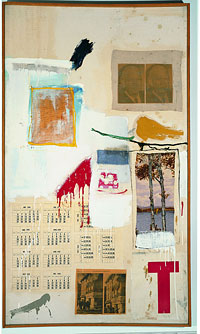
![]() Factum I,
1957
Factum I,
1957
Combine painting
Oil, ink, crayon,
pastel, fabric, newspaper, printed reproductions and printed paper on canvas,
156.2 x 90.8 cm
The Museum of Contemporary
Art, Los Angeles, The Panza Collection
Making an ironic parody of the technique, the use of the subjective [1], Abstract Expressionism and its goal of the absolute, Rauschenberg created twin pieces in 1957, Factum I and Factum II, repeating the same falsely spontaneous brush strokes in both. Through controlled repetition, the pictorial gesture – the sole mark of the artist – is transformed into a stereotype. Indeed, these two works are among the artist’s most conceptual. Repetition is at work and even mise-en-abyme through the presence, within the original and its double, of the number two. There are two images of Eisenhower at the top of each piece, two trees in the slightly off-centre reproduction, and two photographs of the flaming building at the bottom of Factum I and II.
The geometric rigidity of the capital letter T in red corresponds to this sequencing, in contrast with the seemingly random brushstrokes and drips of paint to give the piece magnificent balance. Rauschenberg certainly wanted to show that neither urge nor method alone make an artwork, but rather a mix of intention and chance, impulsive gestures and thought.
Rauschenberg has a complex relationship with Expressionism. Although his painting partly falls within Abstract Expressionism (to which, in this aspect, the artist would be closer than to Pop Art), he has criticised its exhausting repetition to the point of academicism and reacts by reconciling art with life.
It is perhaps in this sense that one ought to understand his famous and scandalous Erased De Kooning drawing from 1952. Rauschenberg asked De Kooning, a painter he admired, to give him a drawing so he could erase it. It is not so much the blasphemous act that matters here, but rather the reworking, the movement of the work, which, like the movement of life, is transformed – in the marks of the eraser included.
Parody is one of the forms
of the broader process of reworking in art.
Whereas reworking and citation characterise the Post-modernism of the 1980s,
the tabula rasa, the blank slate free of all reference has never existed. Even
with the most resounding rupture, the reference to the masters can still be felt.
Cézanne refers back to Poussin, Picasso to Velázquez and Delacroix,
Manet himself in Olympia (1863), an artwork that ruptured existing traditions
if ever there was one, had not forgotten Titian’s Venus of Urbino or
Goya’s Nude Maja.
We could thus pursue the questions raised by parody to bring it into the field
of reworking, compare it for example to pastiche, a form that would be closer
to hommage, and follow the different ways they have been accepted in art and
literature.
[1] In reference to Cy Twombly, Roland Barthes has written that this use is the singular, unreproducible trace of a body, the body of the artist inscribed in the work. (L’Obvie et l’obtus, Seuil, 1982). --> back to the text
THE RELATIONSHIP
OF ARTWORK WITH TIME ![]()
“The past and the future don’t interest me,” Rauschenberg once declared. “I am in the present. I try to extol the present with my limits, but by using all my resources.” (Interview with André Parinaud, op.cit.) And yet time in every sense of the word can be found throughout his work. The temporal dimension is above all depicted through images: images of the artist’s past and of ancient art that travel forward to mix with topical press photos in the Combines.
But temporality finds other expressive means in Rauschenberg’s work: from the omnipresence of mirrors that invite viewers into the work and make them reflect upon it and its immediate present, to the diptych structure of certain Combines, or paintings in two phases, not to mention the inclusion of actual alarm clocks, the artist has not stopped gearing his work to time.
![]() Untitled,
1954
Untitled,
1954
Freestanding combine
Newspaper, photographs,
fabric, printed reproductions, graphite on paper, stickers, found painting,
mirror, shoes and socks on wooden structure with stuffed Plymouth Rock
hen, 219.7 x 94 x 66.7 cm
The Museum of Contemporary
Art, Los Angeles, The Panza Collection
William Rubin has written: “The iconography of the Rauschenberg pictures seems to reach back through time and consciousness, memory by memory.” (William Rubin, “Younger American Painters”, in Art International, vol.4, no.1, January, 1960). In his early Combines, alongside abstract painting, Rauschenberg introduced collages of Images opening onto figuration and autobiography. An autobiography that can be read in the family photographs, pieces of wallpaper, fabric, doors, tied to his childhood and his professional and private life.
Considered the male counterpart
to the Odalisk, this freestanding Combine massively dominates
the space.
The lower section is what first draws the eye to this work comprised
of open boxes set on a structure with casters. A photograph of an elegant
young man dressed in white advances on a mirrored base shared with a Plymouth Rock hen. A curious visual analogy that immediately turns this Combine into
a puzzle that needs solving. Echoing the vertical white silhouette, the
colour white, also on a vertical table leg, is like a column separating
the young man and the hen’s space. The dandy is like a “portrait of the
artist as a young man”, repeated in the many images glued to the upper
section. These images of the artist’s family and professional past reinforce
the fact that this Combine ought to be read
as a portrait of the artist over time. (For a detailed analysis of the
role of the autobiographical in Rauschenberg’s work, see the article by
Paul Schimmel, “Autobiographie et autoportrait dans les Combines”,
in the exhibition catalogue.)
![]() Small
Rebus,
1956
Small
Rebus,
1956
Combine painting
Oil, graphite, painted
swatches of fabric, paper, newspaper, magazine clippings, black and white
photographs, fragments of a map of the United States, fabric and stamps
on canvas, 88.09 x 116.8 x 4.4 cm
Museum of Contemporary
Art, Los Angeles, The Panza Collection
“Rebus” is often the word that comes to the viewer’s mind to describe Rauschenberg’s work, abandoning the idea of discovering its meaning. Resistant to univocal meaning, these contradictory aggregates of images, drips of paint and objects, are established in the viewer’s eye and space as visual riddles that are difficult, if not impossible, to solve. It is not surprising that the artist gave this title to two of his most talked-about artworks: Rebus 1955, and Small Rebus 1956. The intimate images of the artist’s past are paired with those of another past: the history of art.
Just as a reproduction of Botticelli’s The Birth of Venus (1486) appears in Rebus, a reproduction of Titian’s The Rape of Europe (1562) is glued to the surface of Small Rebus. Reading the work from left to right, The Rape of Europe is followed by pictures of a bullfighter, a runner, gymnists, the head of a horse, and the artist’s family. Other images included on the surface of this painting are postage stamps, a child’s drawing of a clock face and a fragment of a map of the northern United States. Rosalind Krauss has underlined the use of this image here and in the Combines, which, she writes, belongs to a process of materialisation. Like the colour and superimposed paper and fabric, the image plays a part in the construction of the image. She adds that their identity as things prevails over their heterogeneity as signs. (L’Originalité de l’Avant-garde et autres mythes contemporains, op.cit. pp. 298-305.)
A single chromatic band crosses
the work lengthwise, dividing it in two. Treated in samples, the horizontal
band covers all the colours of the spectrum, as though the artist wanted
to show and was reflecting upon all of the painting’s possibilities.
This
particularly heterogenous work – images, colours, fabric level out on the surface of the painting – makes
reference, as Rosalind Krasus has emphasised once again, to the “space
of memory”. Impossible to grasp at one go, its perception calls for time.
Rauschenberg, who has always brought out the temperal in his work, wanted
time to be a feature of listening, just as it is with looking. Literally
combining sight and sound, his later Combines,
like Oracle, are both visual and sonorous
collages.
![]() Second
Time painting, 1961
Second
Time painting, 1961
Combine painting
Oil, paper, fabric
and printed reproduction on canvas with alarm clock, 167.3 x 106.7 x 5.7
cm
Rose Art Museum,
Brandeis University, Waltham, Massachusetts
This painting is part of a series in which the notion of time, found in the title, is the origin of its conception. The three artworks of the series, First Time painting, Second Time painting and Third Time painting, were created during a performance that took place at the American Embassy theatre in Paris in 1961.
The painting was set up with its back to the audience so no one could see it being created. Viewers were deprived of observation, but a microphone was attached to the painting so they could hear the artist as he produced the work. An alarm clock stuck to the painting went off when the artwork was finished. At that moment, the artist got up and took his painting backstage, shielding it from the spectators’ eyes. The only thing the audience saw of the painting was what one normally does not see, the time of its creation. By substituting sight for sound, the artist was heard in place of the artwork. A masterly way of bringing the concept and reality of time straight into the work.
Over and above the performance, the paintings, finally visible, each feature an alarm clock that occupies a central position. In Second Time painting, all around the pastel green alarm clock casting its pale double shadow, colour reigns supreme. It makes it way into everything, paper, fabric and reproductions. From pinks and reds, greens smothered in white, to the essential and profound contrast of blacks and whites, colour, applied in changing surfaces and overflowing drips, orchestrates a genuine lesson in painting around the object.
Working “in the gap
between life and art”, as he likes to say, Rauschenberg has never
ceased to push the limits of visual arts. Including life, but also listening
in visual arts and over time, gearing the visual artwork to the moment
of the performance, to the now of perception and to its
“eternity” in artwork, he opened countless avenues for
contemporary artistic creation. From Dadaism to installations, not
to mention video artwork, the inclusion of time is a constant in
20th century visual arts.
From Rauscheberg’s Combines to Bruce Nauman’s long corridors,
from Opalka’s singular counting of time to the portrayal of time as if
suspended in certain Rondinone installations, contemporary art’s encounters
with the experience of time could be the forum for an investigation involving
visual arts, music, philosophy and literature.
Catalogues
• Robert Rauschenberg Combines,
Editions du Centre Pompidou, 2006 ![]()
• Rauschenberg photographe,
Editions du Centre Pompidou, 1981
• Paris New York Paris,
Musée national d’art moderne, Editions du Centre Pompidou, 1977
Reference Works
• Youssef Ishagpour, Rauschenberg, Le monde
comme images de reproduction, Farrago, Tours,
2003
• Rosalind Krauss, “Rauschenberg et l’image matérialisée”,
in L’originalité
de l’avant-garde et autres mythes modernistes, Macula,
1993
Journals
• Catherine Millet, “Le corps morcelé de la sculpture,
Robert Rauschenberg” in Art Press, no. 90,
March, 1985
• Catherine Millet and Myriam
Salomon, interview of Rauschenberg, in Art Press,
no. 65, December, 1982.
• William Rubin “Younger
American Painters”, in Art International,
vol. 4, no.1, January, 1960
Contacts
So that we can provide a service that meets with your requirements, we would
like to have your reactions and suggestions regarding this document.
Contact: centre.ressources@centrepompidou.fr
Centre Pompidou, Public and
Educational Action Unit, October 2006.
Text: Margherita Leoni-Figini, National Educational liaison teacher at the Public
and Educational Action Unit (DEAP)
Translated by Vice Versa
Dossier
on-line, section on ‘Educational Dossiers’ ![]()
Layout: Michel Fernandez
Co-ordination: Marie-José Rodriguez